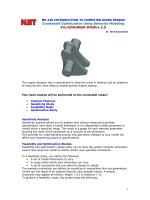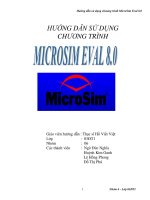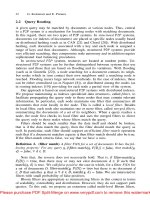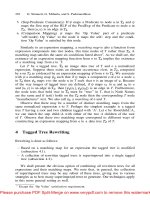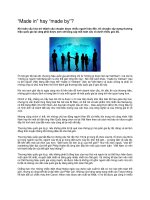Tài liệu Activiti in Action: Executable business processes in BPMN 2.0 ppt
Bạn đang xem bản rút gọn của tài liệu. Xem và tải ngay bản đầy đủ của tài liệu tại đây (13.52 MB, 459 trang )
MANNING
Tijs Rademakers
FOREWORDS BY Tom Baeyens
AND Joram Barrez
Executable business processes in BPMN 2.0
IN ACTION
www.it-ebooks.info
<definitions>
<process>
<startEvent/>
<sequenceFlow/>
<endEvent/>
</process>
</definitions>
Activiti Designer
Activiti Engine
Process implementation
Web forms
Ta sk s
Jobs
Processes
WS
REST
DB
Activiti provides a complete BPM solution, starting with the Activiti Designer to draw your business processes using BPMN.
The XML output of the Activiti Designer is deployed to the Activiti Engine that runs the process definition. The Activiti Engine
executes automated steps, like calling a web service, as well as manual steps that involve people and web forms.
www.it-ebooks.info
Activiti in Action
www.it-ebooks.info
www.it-ebooks.info
Activiti in Action
EXECUTABLE BUSINESS PROCESSES IN BPMN 2.0
TIJS RADEMAKERS
MANNING
Shelter Island
www.it-ebooks.info
For online information and ordering of this and other Manning books, please visit
www.manning.com. The publisher offers discounts on this book when ordered in quantity.
For more information, please contact
Special Sales Department
Manning Publications Co.
20 Baldwin Road
PO Box 261
Shelter Island, NY 11964
Email:
©2012 by Manning Publications Co. All rights reserved.
No part of this publication may be reproduced, stored in a retrieval system, or transmitted, in
any form or by means electronic, mechanical, photocopying, or otherwise, without prior written
permission of the publisher.
Many of the designations used by manufacturers and sellers to distinguish their products are
claimed as trademarks. Where those designations appear in the book, and Manning
Publications was aware of a trademark claim, the designations have been printed in initial caps
or all caps.
Recognizing the importance of preserving what has been written, it is Manning’s policy to have
the books we publish printed on acid-free paper, and we exert our best efforts to that end.
Recognizing also our responsibility to conserve the resources of our planet, Manning books are
printed on paper that is at least 15 percent recycled and processed without the use of elemental
chlorine.
Development editor: Sebastian Stirling
Manning Publications Co. Technical proofreader: Andy Verberne
20 Baldwin Road Copyeditor: June Eding
PO Box 261 Proofreader: Nermina Miller
Shelter Island, NY 11964 Typesetter: Gordan Salinovic
Cover designer: Marija Tudor
ISBN 9781617290121
Printed in the United States of America
1 2 3 4 5 6 7 8 9 10 – MAL – 17 16 15 14 13 12
www.it-ebooks.info
v
brief contents
PART 1 INTRODUCING BPMN 2.0 AND ACTIVITI 1
1 ■ Introducing the Activiti framework 3
2 ■ BPMN 2.0: what’s in it for developers? 19
3 ■ Introducing the Activiti tool stack 32
4 ■ Working with the Activiti process engine 49
PART 2 IMPLEMENTING BPMN 2.0 PROCESSES WITH ACTIVITI 85
5 ■ Implementing a BPMN 2.0 process 87
6 ■ Applying advanced BPMN 2.0 and extensions 112
7 ■ Dealing with error handling 146
8 ■ Deploying and configuring the Activiti Engine 169
9 ■ Exploring additional Activiti modules 193
PART 3 ENHANCING BPMN 2.0 PROCESSES 223
10 ■ Implementing advanced workflow 225
11 ■ Integrating services with a BPMN 2.0 process 260
12 ■ Ruling the business rule engine 286
www.it-ebooks.info
BRIEF CONTENTS
vi
13 ■ Document management using Alfresco 311
14 ■ Business monitoring and Activiti 340
PART 4 MANAGING BPMN 2.0 PROCESSES 367
15 ■ Managing the Activiti Engine 369
www.it-ebooks.info
vii
contents
foreword by tom baeyens xv
foreword by joram barrez xvii
preface xix
acknowledgments xxi
about this book xxiii
about the cover illustration xxviii
PART 1 INTRODUCING BPMN 2.0 AND ACTIVITI 1
1
Introducing the Activiti framework 3
1.1 The Activiti tool stack 4
1.2 Getting to know Activiti 5
A little bit of history 5
■
The basics of the Activiti Engine 6
Knowing the competitors 7
1.3 Installing the Activiti framework 9
1.4 Implementing your first process in Activiti 11
Say hello to Activiti 12
■
Implementing a simple book order
process 14
1.5 Summary 18
www.it-ebooks.info
CONTENTS
viii
2
BPMN 2.0: what’s in it for developers? 19
2.1 Taking a closer look at BPM 20
Walking around the BPM life cycle 21
2.2 Evolution to BPMN 2.0 22
Wasn’t there a standard called WS-BPEL? 22
■
And then there
was BPMN 2.0 23
■
Getting your head around all the BPMN 2.0
constructs 24
2.3 Introducing BPMN 2.0 from a developer’s viewpoint 26
High-level modeling with BPMN 2.0 26
■
Detailed process modeling 28
2.4 Summary 31
3
Introducing the Activiti tool stack 32
3.1 Working with the Activiti Modeler 33
Installing the Activiti Modeler 33
■
Modeling processes with the
Activiti Modeler 34
3.2 Adding technical details with the Activiti Designer 36
Getting up and running with Activiti Designer 36
■
Designing a
process from scratch 37
■
Testing processes with the Activiti
Designer 39
■
Importing a Modeler process into the Designer 42
3.3 Managing the Engine using the Activiti Explorer 45
3.4 Processes and tasks with the Activiti Explorer 46
3.5 Summary 48
4
Working with the Activiti process engine 49
4.1 Creating an Activiti development environment 50
Getting familiar with the Activiti libraries 50
■
Mavenizing your
Activiti project 51
■
Logging in the Activiti Engine 53
Developing and testing with the Activiti Engine 54
4.2 Using the Activiti Engine API 56
Starting process instances with the RuntimeService 57
■
Working
with user tasks via the TaskService 59
■
Deleting process
definitions with the RepositoryService 64
■
Creating users, groups,
and memberships with the IdentityService 66
■
A sneak peek into
the past with the HistoryService 67
4.3 Using plain Java to do BPM 72
Java service task with class definition 73
■
Introducing asynchronous
behavior 75
■
Java service task with class definition and field
extensions 76
■
Java service task with method and value expressions 78
www.it-ebooks.info
CONTENTS
ix
4.4 Using Spring with Activiti 79
Creating a generic Spring configuration for Activiti 79
Implementing a Spring-enabled unit test for Activiti 81
4.5 Summary 84
PART 2 IMPLEMENTING BPMN 2.0 PROCESSES
WITH ACTIVITI 85
5
Implementing a BPMN 2.0 process 87
5.1 Introducing a real business process 88
Analyzing the loan request process 88
■
Taking a process model to
an XML process file 89
5.2 Developing script and service tasks 90
Scripting in the Activiti Engine 90
■
Implementing a Java service
task 92
■
Creating the BPMN 2.0 XML file 93
■
Testing the
process with JUnit 94
5.3 Interacting with user tasks and Activiti forms 95
Creating forms in Activiti 95
■
Adding a task form on a start
event 96
■
Testing forms using the FormService 97
■
Adding
user tasks with an escalation workflow 98
5.4 Handling decisions and sending email 101
Controlling flow with an exclusive gateway 101
■
Implementing
an email service task 102
5.5 Deploying processes to the Activiti Engine 106
Understanding the Activiti BAR file 106
■
Deploying processes to
the Activiti Engine 107
5.6 Testing the process with Activiti Explorer 109
5.7 Summary 111
6
Applying advanced BPMN 2.0 and extensions 112
6.1 Using BPMN 2.0 subprocesses 113
Background to BPMN subprocesses 113
■
Implementing embedded
subprocesses 114
■
Implementing standalone subprocesses 120
6.2 Working with BPMN 2.0 parallel gateways 126
Implementing a process with a parallel gateway 127
■
Testing a
process with a parallel gateway 129
6.3 Adding a JPA extension to your process 130
Modeling a process with a database entity 131
■
Implementing a process
with JPA extensions 132
■
Testing a process with JPA extensions 136
www.it-ebooks.info
CONTENTS
x
6.4 Using execution and task listeners 137
Modeling a process with execution and task listeners 138
Implementing execution and task listeners 139
■
Testing the event
stack list 142
6.5 Summary 144
7
Dealing with error handling 146
7.1 Choosing between error handling options 147
Using error end and boundary events 147
■
Using Java logic for
error handling 149
■
Using both error handling approaches
together 151
7.2 Implementing error handling with BPMN 2.0
constructs 152
Designing the sales opportunity process solution 152
■
Modeling
the sales opportunity business process 154
■
Implementing a
BPMN process with the Activiti Designer 155
■
Implementing
service tasks that invoke a web service 160
■
Testing the sales
opportunity process solution 163
7.3 Implementing error handling using Java logic 165
7.4 Summary 168
8
Deploying and configuring the Activiti Engine 169
8.1 Choosing between deployment options 170
Embedding the Activiti Engine in a Java application 170
■
Using
a standalone Activiti Engine instance 172
■
Choosing between the
deployment options 175
8.2 Using a Spring-managed Activiti Engine 176
Creating a process engine from a config file or Java 176
■
Creating
a process engine from a Spring configuration 177
8.3 Configuring the Activiti Engine 181
Basic configuration overview of the Activiti
Engine 181
■
Configuring the Activiti Engine database
options 182
■
Exploring other configuration options 184
8.4 REST communication with the Activiti Engine 185
Introducing the Activiti REST API 185
■
Implementing a new
Activiti REST service 187
8.5 Summary 192
www.it-ebooks.info
CONTENTS
xi
9
Exploring additional Activiti modules 193
9.1 Spring annotations 194
9.2 Building an Activiti JEE 6 application 196
Implementing EJB service tasks 197
■
Implementing a JSF process
application using CDI 202
9.3 Deploying Activiti to an OSGi container 209
Introducing the OSGi standard 209
■
Using Apache Karaf as an
OSGi container 210
■
Installing the Activiti OSGi bundle 211
Getting a list of process definitions in Apache Karaf 215
Building a process and task OSGi bundle 217
9.4 Summary 221
PART 3 ENHANCING BPMN 2.0 PROCESSES 223
10
Implementing advanced workflow 225
10.1 Going beyond a simple user task 226
Working with subtasks 226
■
Delegating tasks 231
Implementing the four-eye principle 233
10.2 Managing the user identities in an LDAP server 236
Installing Apache Directory Server 237
■
Writing LDAP query
logic for the Activiti Engine 241
10.3 Implementing the BPMN 2.0 multi-instance activity 246
Configuring a multi-instance activity 246
■
Implementing a
multi-instance embedded process 247
10.4 Custom form types and external form rendering 253
Implementing a custom form type 253
■
Using external form
rendering 257
10.5 Summary 259
11
Integrating services with a BPMN 2.0 process 260
11.1 Invoking services from a BPMN 2.0 process 261
Calling services via a service task 261
■
Separating process logic
from integration logic 262
11.2 Using the BPMN 2.0 web service task 264
11.3 Integrating with Apache Camel 268
Introducing Apache Camel 268
■
Sending and receiving process
messages with Apache Camel 272
www.it-ebooks.info
CONTENTS
xii
11.4 Integrating with Mule ESB 276
Introducing Mule ESB 276
■
Sending and receiving process
messages with Mule ESB 280
11.5 Summary 285
12
Ruling the business rule engine 286
12.1 Introducing business rule management 287
What’s a business rule? 287
■
Business rule management
systems 288
■
Using different types of rules in business
processes 289
■
Business rule management in BPMN 2.0 291
12.2 Entering the rule world of Drools 292
Drools, the business logic integration platform 292
■
Introducing
Drools Expert 293
■
Hands-on with Drools Expert 296
■
Using
spreadsheets to create Drools decision tables 298
12.3 Integrating Drools with Activiti 301
Activiti and the business rule task 301
■
Using business rules in a
process definition 303
12.4 Creating a web-based rule editor 307
Introducing flexibility with a custom rule authoring application 307
12.5 Summary 309
13
Document management using Alfresco 311
13.1 Introducing Alfresco Community 312
Installing Alfresco Community 312
■
Introducing Activiti
integration in Alfresco 315
13.2 Using CMIS to store and retrieve documents 320
Retrieving folder content from Alfresco using CMIS 320
■
Storing
a new document version 323
13.3 Adding documents to a BPMN 2.0 process definition 326
Working with task and process instance attachments 326
Implementing a document-aware process definition 328
Deploying and testing the document-aware process definition 336
13.4 Summary 338
14
Business monitoring and Activiti 340
14.1 Monitoring business processes 341
Introducing business activity monitoring (BAM) 341
Introducing complex event processing (CEP) 343
www.it-ebooks.info
CONTENTS
xiii
14.2 Meeting the Esper framework 345
Kick-starting Esper 345
■
Introducing event windows 347
14.3 Monitoring Activiti processes with Esper 355
Integrating Activiti and Esper 355
■
Testing the Activiti and
Esper setup 356
14.4 Monitoring Activiti with a Vaadin dashboard 359
An Activiti BAM architecture 359
■
Producing REST events with
Activiti 360
■
Setting up the Vaadin application with the Esper
REST service 362
■
Monitoring Activiti processes with a Vaadin
dashboard 364
14.5 Summary 366
PART 4 MANAGING BPMN 2.0 PROCESSES 367
15
Managing the Activiti Engine 369
15.1 Working with the Activiti database 370
Understanding the Activiti runtime execution database model 370
Understanding the Activiti history database model 377
■
Creating
the Activiti database 379
■
Upgrading the Activiti database 380
15.2 Dealing with process versioning 381
15.3 Understanding the job executor 384
15.4 Building an administrator dashboard 386
15.5 Summary 392
appendix A Working with the source code 395
appendix B BPMN 2.0 supported elements in Activiti 398
index 418
www.it-ebooks.info
www.it-ebooks.info
xv
foreword by tom baeyens
Business processes represent the core functions of an organization. If these core
functions are implemented inefficiently, a company gives its competitors an easy
advantage. Business Process Management (
BPM) is nothing more than ensuring that
an organization is run well and remains in good shape. For small companies, a single
person might be able to oversee everything that is going on and deal with situations
as they occur. But when companies grow larger and processes expand, it’s harder to
maintain control. Work is delegated, people start optimizing their own responsibili-
ties, and an overview can quickly get lost. Over the long run, constant monitoring
and improving of business processes are what separates good organizations from
excellent ones.
One aspect of managing business processes is automation. Despite big advance-
ments in software technology in the last decade, building custom software to support
business processes remains expensive for enterprises.
Traditional
BPM Systems (BPMSs) have attempted to simplify the creation of soft-
ware for monitoring business processes. The biggest advantage of BPMSs is that they’re
based on flowchart diagrams. Business managers and technical team members can
understand these diagrams, which helps bring communication of requirements to a
new level.
The bottleneck of traditional
BPMSs has been flexibility. BPMSs that focus on tech-
nical integration with backend systems over web services (for example, BPEL) are not
suited for business people. And BPMSs that focus on business diagrams are typically
limited in backend integration and scripting.
www.it-ebooks.info
FOREWORD BY TOM BAEYENS
xvi
This lack of flexibility is why I started building a home-brewed process engine back
in 2002. Initially, the goal was to build an interpreter for state machines. It was much
later that I heard from many developers that they had gone through the same initial
phase. Originally, my process engine was intended as an internal project for which I
was doing Java consulting.
Without expectations and without really knowing what I was getting myself into, I
published the project on SourceForge as j
BPM. My reaction to the first forum post was,
“Cool! Someone found my engine!”—and this motivated me to improve. Many more
forum posts kept me going until
JBoss came along and asked me to develop it further.
After the Business Process Model and Notation (BPMN) standard was introduced,
we realized that it would be crucial to have an Apache-licensed implementation of
BPMN. jBPM’s LGPL could pose a problem for mass adoption. At the same time,
Alfresco needed an Apache-based BPMN engine, so the company hired me, and that is
how Activiti was born. Because of the different licenses, we couldn’t use any of the
j
BPM code, so we had to write it from scratch at Alfresco: but this became an opportu-
nity to revisit all the key architectural decisions that had been made before.
During the evolution of j
BPM, leading up to Activiti, I took a new approach to
the old problem. Initially, the focus was on state machines, but eventually we con-
structed an engine to match the way business people and developers collaborate. We
designed the engine in such a way that it would allow business people to define the
graphical flow of the process and, at the same time, give developers the opportunity
to bind program logic inside the process flows. In addition, the engine was light-
weight and integrated easily into any Java environment. The result was what we call
embeddable
BPM.
BPMN is a recent standard that has emerged from a long list of predecessors in the
BPM space. It describes the shapes and connections for drawing business-process dia-
grams as well as their meanings and file formats. BPMN is different because of its clear
focus on the business side and process modeling, whereas earlier standards focused
more on the technical aspects.
In this book, Tijs has included concrete instructions for developers, technical man-
agers, and business analysts to start building
BPMN process solutions with Activiti. The
book includes a comprehensive overview of the Activiti framework, the Activiti
Engine, and
BPMN. But Tijs goes beyond the basics and describes how to integrate
these with a rule engine and web-based services.
The reader will get a thorough understanding of
BPM technology as it is applied in
today’s enterprise environments. This is definitely the most practical guide to BPMN
using Activiti as the engine.
TOM BAEYENS
ACTIVITI AND JBPM FOUNDER
CHIEF BPM ARCHITECT, ALFRESCO
www.it-ebooks.info
xvii
foreword by joram barrez
A picture is worth a thousand words
I believe this is a saying that exists in every culture around the world. And, truly, our
minds are impressive image-processing machines, spotting structure and anomalies in
a fraction of a second. Yet we tend to base much of our daily communication, both
personal and professional, on the written word.
As software developers, we live in the most interesting of times, with the World
Wide Web, the mobile (r)evolution, and the movement to the cloud with a clear focus
on consumers. Yet the building process of that software remains complex—we pro-
duce pages and pages of lengthy documents to describe what we would like to see
emerge from that ocean of zeroes and ones.
What if there were a way to improve this situation? As it happens, improving this
situation is the main goal of those who are involved with
BPM.
I started my career as a typical Java developer, a generalist doing tids and tads of
everything involving Java. One day, out of the blue, I was assigned to a j
BPM project. At
that point, I had never heard of BPM or anything close to it. Long story short: I fell in
love. I devoted my days, nights, and weekends to understanding the inner workings of
the engine. Open source is a powerful potion, and I drank it. The community was
hard to please (I got an “rtfm” on my first post) but responsive to those who were will-
ing to learn and to share their knowledge.
It was, as the French would say, a coup de foudre (love at first sight). I worked on
BPM
projects coding during the day, and I lurked on the forums at night. And then it hap-
pened. About a year after my first encounter with BPM, I met Tom Baeyens, the proj-
ect lead of jBPM at the time, at a seminar where we both were speakers. We connected
www.it-ebooks.info
FOREWORD BY JORAM BARREZ
xviii
immediately as fellow geeks. A year later, I joined his team at JBoss and followed him
subsequently to help build Activiti at Alfresco.
Why the switch? The answer is simple. There was no room for an Apache-licensed
engine at
JBoss at that time, but we knew that an Apache license was crucial due to the
advent of the BPMN 2.0 standard. If we weren’t going to do it, someone else would.
Putting all our experiences together—what worked, what didn’t work, and what
rocked—we started to build a
BPMN 2.0 engine at the beginning of 2010, an engine that
would do exactly what I started my story with: improve communication between those
who need software solutions and those who build software by using flowchart-like dia-
grams. Expressing how your business works with diagrams is hard, but it is worth the
effort. Visualization is a powerful tool and, in the past, I often saw clients change their
way of working after seeing how the different steps connected. The
BPMN 2.0 standard
is of great value here. It may seem simplistic, but by defining how certain shapes have
specific meanings, not only can you visualize your workflows, you can find others in the
industry who speak the same language. The fact that version 2.0 also includes execution
semantics adds the next level of power: not only do the diagrams become standardized,
but now you can switch the engine that’s executing the diagrams with any
BPMN 2.0–
compliant engine—not that there is any reason to switch from Activiti, of course!
As a Java developer, I used to loathe
BPM suites—big black boxes that cost tons of
money to produce pictures. Every sane developer understands that pictures will never
make it into stable, performant software. That is why you will love Activiti: it is built
with benefits for business users in mind, without forgetting the developers. All the
code is open source—if something bothers you or isn’t clear, you can join our discus-
sions on the forum. Activiti in its simplest form is a library, a
JAR, one among many,
embeddable in every Java project, be it EE, Spring, or OSGi. With Activiti, you write
unit tests just as you are used to doing. But instead of testing code, you are testing pro-
cesses—based on diagrams that you and the business people discussed and under-
stood—enriched with Java code to make them do exactly what you want them to do.
Then you integrate them with other components exactly as you envisioned.
I touch only briefly here on the benefits of
BPM and the power of Activiti. Tijs does
an outstanding job of covering every facet of Activiti in great detail, and I’m excited
and thankful that he put so much time into this book project. Software and open
source frameworks in general rise or fall with the available documentation, and it’s my
belief that this is a superb book that provides much-needed, detailed information.
There currently is no better source of knowledge on Activiti and
BPMN 2.0. Period.
Think about it: processes are all around us. Without processes, a company
wouldn’t exist or, at least, it wouldn’t make money for long. Every company needs pro-
cesses to fulfill its goals. And in this quickly changing world, opportunities exist every-
where, from mobile integration in the workflow to massive cloud services
orchestrations. It’s up to you to grab them.
J
ORAM BARREZ
COFOUNDER OF ACTIVITI
CORE ACTIVITI DEVELOPER, ALFRESCO
www.it-ebooks.info
xix
preface
Writing this book was a life-changer for me. After I wrote Open Source ESBs in Action for
Manning a few years ago, I focused on my daily job for some time, working with open
source enterprise integration frameworks like Mule, Camel, ServiceMix, and Spring
Integration. My work, over time, drove me to designing and developing processes and
BPM, and I started using jBPM and WebSphere Process Server. Then I learned that the
founder of the jBPM project, Tom Baeyens, was leaving JBoss to work on a new open
source project, which was in stealth mode at that time (early 2010). When the first
alpha version of Activiti was released, I told myself I had to contribute to that project,
one way or another.
A piece that was missing in the first stages of the Activiti project was an Eclipse
plug-in. I had some email conversations with Tom about contributing the plug-in to
Activiti. We met and he told me that his goal was to disrupt the process engine space
with the Activiti project. My enthusiasm grew even more and I offered my time to start
working on a first version of the Activiti Designer. Together with my former col-
leagues, Tiese Barrell, Yvo Swillens, and Ron van Liempd, we were able to deliver a
first version within a couple of months.
As we became part of the Activiti developer community, my hands were itching to
start writing a book about Activiti. I felt that a great open source process engine would
need a detailed book to describe all the possibilities and potential it offers. Manning
was eager to publish a book about Activiti, and, together with Ron, we started writing
in the autumn of 2010. We had a hard time keeping up with the frequent releases and
the new functionality that kept on coming. But, it also was a lot of fun to be able to
write about a new functionality that was just (or about to be) released.
www.it-ebooks.info
PREFACE
xx
After a few meet-ups with the Activiti developer community and a couple of nice
dinners with the Activiti team, we began discussing the possibility of my joining
Alfresco to work on Activiti. In May 2011, I accepted the offer and was able to begin
working on Activiti full-time.
In the meantime, the writing of this book fell a little behind schedule. There was
so much interesting work to be done developing the Activiti Designer, working on
the Activiti Engine, and starting in a new job, that time caught up with me. After I
had settled in a bit, I took up the writing task again and began working on the
remaining chapters.
So here I am, at the end of the process. I’ve switched from being a consultant to an
open source software engineer, and I’m close to completing my second book. And, just
like with my previous book, I have a new family addition coinciding with the book’s
release. I hope you will enjoy reading this book as much as I loved writing it!
www.it-ebooks.info
xxi
acknowledgments
Many people deserve thanks for helping me with this book project. First of all, I want
to thank Ron for starting this adventure with me and for his contributions to the book.
A big thank you to the guys on the Activiti team—Tom, Joram, and Frederik—for
starting this great open source project and for all the help they gave me during the writ-
ing of the book. Special thanks to Tom and Joram for kindly contributing the forewords.
I’d also like to thank the guys at camunda (Bernd and Daniel, in particular) for
their contribution to the Activiti project and for their help when I was writing about
the camunda fox cycle and the Activiti
CDI module.
Thanks to Balsamiq Studios and Giacomo “Peldi” Guilizzoni for providing licenses
for their great Balsamiq tool. I really enjoyed creating the graphics for this book.
Thanks to Tiese Barrell and Yvo Swillens for their enthusiasm and development
work on the Activiti Designer. Together we became part of the great Activiti devel-
oper community.
A special thank-you to Andy Verberne for his work on the technical proofread of
the final manuscript (again).
Without the patience of my lovely Ankie, the writing of this book would not have
been possible. She managed to love me, even after long working days and in spite of
my sometimes grumpy communication when examples were not working as expected.
Liv and Noah, thank you for all the joy you bring to my life. Thanks to my parents and
parents-in-law for their love and interest in my writing.
Thanks also to the following reviewers of the manuscript who read it and provided
feedback during the various stages of its development: Gil Goldman, Michał Minicki,
www.it-ebooks.info
ACKNOWLEDGMENTS
xxii
Sven Vintges, Joram Barrez, Jeff Davis, Gordon Dickens, Roy Prins, Claus Ibsen, Feder-
ico Tomassetti, Greg Helton, Mykel Alvis, and Nicolas Leroux.
Finally, my appreciation to everyone at Manning, starting with publisher Marjan
Bace, my editor Sebastian Stirling, and the production team of June Eding, Nermina
Miller, Mary Piergies, Gordan Salinovic, and Janet Vail.
www.it-ebooks.info
xxiii
about this book
Activiti is an open source Business Processing Model and Notation (BPMN) 2.0 process
engine framework that provides an environment for running your business and tech-
nical processes. It’s a project funded by Alfresco and established by j
BPM founder Tom
Baeyens. Activiti provides much more functionality than simply running BPMN 2.0 pro-
cesses in a rock-solid way. It provides a web-based modeling tool for business analysts, an
Eclipse plug-in for developers, and a web application to work with and manage the pro-
cesses. In addition, Activiti community members, including SpringSource, FuseSource,
MuleSoft, and camunda, have implemented further functionality like full Spring inte-
gration, an OSGi bundle, Mule and Camel integration, and a
CDI module.
This book is written by one of the Activiti core developers and the lead developer
of the Activiti Designer component. It contains loads of examples to help you under-
stand the
BPMN 2.0 language and how to work with all the extensions Activiti provides.
In the final chapters, the book goes beyond Activiti’s core functionality and shows how
to do
CMIS communication from a process definition and how to implement a busi-
ness activity monitoring environment using the open source Esper framework.
You should not expect to find examples of all the nitty-gritty details of the
BPMN 2.0
specification. Instead, the focus is on Activiti-supported elements and the most common
use cases for developing process definitions.
You also won’t find in-depth discussions of the business side of
BPM. Many other
books focus on the business perspectives of BPM; this book focuses on the technical
aspects of BPM, mostly on BPMN 2.0 and Activiti.
www.it-ebooks.info



